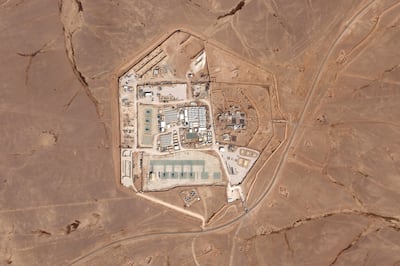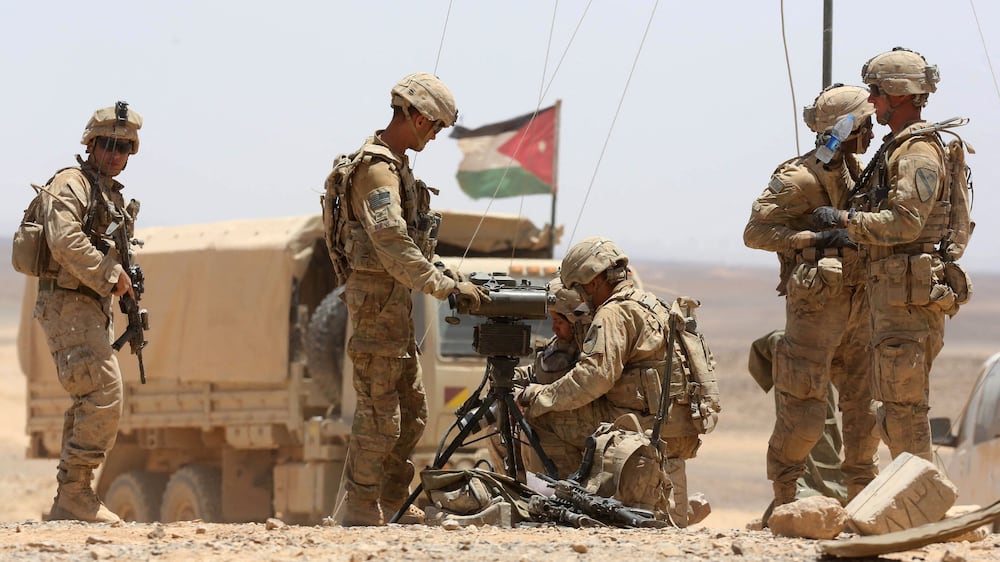Live updates: Follow the latest news on Israel-Gaza
The Pentagon is considering how best to respond to a Tehran-linked drone attack that killed three US troops at a small military base in Jordan as the risk of a broader clash with Iran grows by the hour.
Publicly, Iran and the US have declared their intention to avoid direct conflict, but US President Joe Biden's administration is under mounting political pressure to increase attacks on Iranian-backed militias in Iraq and Syria, and some Republican hawks are calling for direct strikes on Iran.
“We are not looking for a war with Iran … we will not seek to escalate,” said White House National Security Council spokesman John Kirby after Sunday's Iran-backed attack on Tower 22, an isolated US outpost that hosts about 350 troops in the Iraq-Syria-Jordan border area.
“But we will absolutely do what is required to protect ourselves to continue that mission and to respond appropriately to these attacks.”
At least 34 US service members were wounded, a US defence official told The National, and the number was expected to rise further as troops developed symptoms consistent with traumatic brain injuries.
Eight were medically evacuated for further evaluation but all of them are in a stable condition.
The tower has been a target twice in the past six months but the attacks were thwarted by air-defence systems, the official added.
Pentagon spokeswoman Sabrina Singh said many of those wounded had been in bed when the drone struck their barracks in the early morning attack.
The Pentagon is investigating how the attack drone managed to evade defences. The Wall Street Journal reported there appeared to have been a mix-up over the drone's identity, with operators confusing it with a returning US aircraft.
Tehran, through its UN mission, said it was not involved in the drone attack in north-eastern Jordan. An official statement said Iran had “nothing to do with it” but did not deny US accusations that militia allied with Tehran were behind it.
Qatari Prime Minister and Minister of Foreign Affairs Sheikh Mohammed bin Abdulrahman bin Jassim Al Thani condemned the attack and said it breached Jordanian sovereignty.
“An attack that happened in Jordan is infringing Jordan's sovereignty, also undermining the force of the coalition against ISIS [and] is not something that can be accepted,” he said at an event in Washington.
Meanwhile, in London, Rishi Sunak called for calm.
“We are concerned and would urge Iran to continue to de-escalate tensions in the region,” the UK Prime Minister said.

The drone attack has intensified tension linked to the war between Israel and Iran-backed Palestinian militant group Hamas in Gaza.
Since October, the Pentagon has blamed Iran-backed militias for more than 165 attacks on US forces in Iraq and Syria.
Further complicating the fraught picture, Tehran-supported Houthi rebels in Yemen have unleashed dozens of attacks on merchant and military vessels in the Red Sea.
A pro-Iranian source in Beirut said the Israeli killings of Iranian military officials in Syria over the past two months have been a factor behind the escalation and warned of further attacks against US.
Another factor is Tehran's desire to weaken Washington in negotiations with Baghdad over the withdrawal of US forces.
The source cited the “intensity” of Houthi missile attacks in the Red Sea and the use of more advanced missiles by Hezbollah in a continuing border war of attrition with Israel as “good examples” of Iran's intention to carefully widen the Gaza conflict.
“Regional escalation has been expected and prepared for,” the source said, referring to the Iran-backed militias in the region.
Mr Biden on Sunday vowed that the US would respond to the attack in Jordan, a message repeated by Defence Secretary Lloyd Austin.
“Let me start with my outrage and sorrow [for] the deaths of three brave US troops in Jordan and for the other troops who were wounded,” Mr Austin said at the start of a meeting with Nato Secretary General Jens Stoltenberg.
“The President and I will not tolerate attacks on US forces and we will take all necessary actions to defend the US and our troops.”

The Republican response to the killings has been united in condemning the Biden administration but disjointed on exactly why.
Donald Trump, the former president and presumptive Republican nominee in the 2024 presidential election, called the “brazen attack on the United States” by Iranian-linked forces “another horrific and tragic consequence of Joe Biden's weakness and surrender”.
Hawkish Republican senator Lindsey Graham called on the US to “strike targets of significance inside Iran” and to “hit them hard”.
But under Mr Trump, many Republicans vowed to keep the US out of new foreign wars.
French Hill, a Republican congressman who sits on the House Foreign Affairs Committee, told The National: “It's appropriate to have a proportionate response that targets Iranian Revolutionary Guard and Iranian militia elements, no matter where they're located, if we have the intelligence to support a planned strike.”
“I'm not taking any particular geography off the table,” he said.
Sunday’s drone attack also highlighted America’s lingering presence in the region six years after the near-total defeat of ISIS.
The base is one of several established to counter the extremists, with six other sites in Syria. These are distinct from those in Iraq, such as the vast Al Asad airbase.
The latter hosts thousands of Iraqi troops alongside some Nato advisers and is protected by cutting-edge Patriot air defences.
By comparison, Tower 22, which supported a nearby outpost in Syria, is vulnerable.
Similar bases were set up after 2015 when small contingents of US special operations forces entered Syria, teaming up with beleaguered Kurdish militias who were fighting the ISIS onslaught at the time.
Tower 22 has been described as a support base for the nearby US Al Tanf garrison and exists in a “deconfliction zone” in the Iraq-Syria-Jordan border area, established in 2016 during a shaky agreement between the US and Russia.
The attack calls into question whether America’s decades-long stand-off with Iran is heading towards a dangerous new phase, after years in which the US and Iran’s allies clashed but often backed off from full-scale war.
“That’s certainly a risk,” said Raphael Cohen, an analyst specialising in US air power with the Rand Corporation think tank.
Iran-backed militias have clashed with US forces during their presence in Iraq between 2003 and 2011, and 2014 and the present. But the clashes in Syria are relatively new and began in 2017.
Iran’s proxies, including militias on the Iraqi government payroll that are part of an organisation called the Popular Mobilisation Forces, were behind most attacks.
Amid the Gaza war, some PMF units such as Kataib Hezbollah and Harakat Hezbollah Al Nujaba have claimed to support Palestine against the US and Israel, worsening tension.
“The fact that these groups haven’t killed Americans from October 7 until now is more a testament to American air defences and, frankly, lots of good luck, rather than a lack of intent,” Mr Cohen says.
“At the same time, it seems to me that this latest attack and the [approximately 165] that preceded it demonstrate that Iran and its proxies are already intent on escalating,” he told The National.






